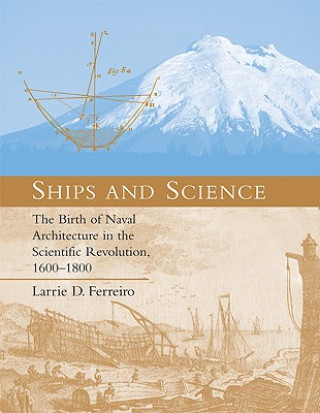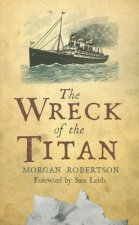
Kód: 04561571
Ships and Science
Autor Larrie D. Ferreiro
"Naval architecture was born in the mountains of Peru, in the mind of a French astronomer named Pierre Bouguer who never built a ship in his life." So writes Larrie Ferreiro at the beginning of this pioneering work on the science ... celý popis
- Jazyk:
 Angličtina
Angličtina - Väzba: Brožovaná
- Počet strán: 472
Nakladateľ: MIT Press Ltd, 2010
- Viac informácií o knihe

45.66 €
Bežne: 46.56 €
Ušetríte 0.90 €
Dostupnosť:
50 % šanca Máme informáciu, že by titul mohol byť dostupný. Na základe vašej objednávky sa ho pokúsime do 6 týždňov zabezpečiť.
Máme informáciu, že by titul mohol byť dostupný. Na základe vašej objednávky sa ho pokúsime do 6 týždňov zabezpečiť.Prehľadáme celý svet
Mohlo by sa vám tiež páčiť
-

All Our Hidden Gifts
9.12 € -23 % -

Reality transurfing. Steps I-V
73.87 € -

Jurassic Park
9.73 € -24 % -

The Electric State
24.95 € -21 % -

Wild at Home
19.27 € -18 % -

G.O.A.T. - Lebron James
9.83 € -3 % -

Game Changer
22.42 € -14 % -

Halo: The Fall of Reach: Volume 1
15.62 € -23 % -

Madonna in a Fur Coat
9.83 € -24 % -

Women Don't Owe You Pretty
14.50 € -24 % -

Chinese Air Power
55.50 € -2 % -

Unsettled
19.88 € -29 % -

Blood on the Tracks 6
11.86 € -17 % -

Certified Kubernetes Application Developer (CKAD) Study Guide
44.74 € -21 % -

Eminence in Shadow, Vol. 3 (light novel)
17.04 € -19 % -

Practical Tips on How to Contract: Techniques and Tactics from an Ex-BigLaw and Ex-Tesla Commercial Contracts Lawyer
15.82 € -2 % -

Sino-Soviet Border War of 1969, Volume 1
30.44 € -2 % -

Modern Software Engineering
39.87 € -2 % -

Gilmore Girls: The Official Cookbook
28.51 € -14 % -

Mermaids and Animal Companions Coloring Book
13.18 € -

Anatomy: A Love Story
16.43 € -23 % -

Fundamentals of Data Engineering
66.66 € -16 % -

Kanji From Zero! 2
36.12 € -11 % -

Demon Slayer: Kimetsu no Yaiba-One-Winged Butterfly
10.65 € -8 % -

Victorian Floral Illustrations
13.59 € -15 % -

Harry Potter and the Chamber of Secrets
17.24 € -20 % -

Art of Application Performance Testing 2e
36.22 € -21 % -

World's Greatest Blackjack Book
14.10 € -18 % -

Story of King Arthur and His Knights (Barnes & Noble Collectible Classics: Children's Edition)
26.88 € -23 % -

Keepers of the Light Oracle Cards
20.19 € -22 % -

Road to Serfdom
17.44 € -3 % -

100 Tips for Hoteliers
14.60 € -19 % -

Only Love Is Real
14.30 € -23 % -

Japanese from Zero! 2
50.83 € -

Hours
11.05 € -23 % -

Star Trek: The Art of the Film
21.61 € -38 % -

Little Book of Language
13.99 € -11 % -

Propaganda Front
40.18 € -5 % -

Starting Out : The Accelerated Dragon
23.33 € -17 % -

Sindbad the Sailor
2.53 € -20 % -

Jesus Calling, Padded Hardcover, with Scripture References
13.28 € -21 % -

How to Diagnose and Fix Everything Electronic, Second Edition
24.14 € -16 % -

World is Full of Foolish Men
3.54 € -24 % -

Selection
21 € -1 % -

2,286 Traditional Stencil Designs
14.60 € -19 % -

CATIA V5 Tutorials Mechanism Design & Animation Release 21
87.47 € -

Sex: A Man's Guide
12.88 € -

Ry Sai Kenbo: The Educational Ideal of 'Good Wife, Wise Mother' in Modern Japan
144 € -

Emotion-Focused Therapy
46.47 € -11 % -

Gathering Moss
16.23 € -19 % -

Das große Stickerhaus
7.40 € -2 % -

Bóg Imperator Diuny. Kroniki Diuny. Tom 4 wyd. 2022
10.85 € -11 % -

Spowiedź Hitlera 2 Szczera rozmowa po 20 latach
11.25 € -

Kupka Monographie
18.26 € -

El Greco
11.36 € -8 % -

TOKYO AT NIGHT (VO JAPONAIS)
49.11 €
Darčekový poukaz: Radosť zaručená
- Darujte poukaz v ľubovoľnej hodnote, a my sa postaráme o zvyšok.
- Poukaz sa vzťahuje na všetky produkty v našej ponuke.
- Elektronický poukaz si vytlačíte z e-mailu a môžete ho ihneď darovať.
- Platnosť poukazu je 12 mesiacov od dátumu vystavenia.
Informovať o naskladnení knihy
Zadajte do formulára e-mailovú adresu a akonáhle knihu naskladníme, zašleme vám o tom správu. Postrážime všetko za vás.
Viac informácií o knihe Ships and Science
Nákupom získate 114 bodov
 Anotácia knihy
Anotácia knihy
"Naval architecture was born in the mountains of Peru, in the mind of a French astronomer named Pierre Bouguer who never built a ship in his life." So writes Larrie Ferreiro at the beginning of this pioneering work on the science of naval architecture. Bouguer's monumental book Trait du navire (Treatise of the Ship) founded a discipline that defined not the rules for building a ship but the theories and tools to predict a ship's characteristics and performance before it was built. In Ships and Science, Ferreiro argues that the birth of naval architecture formed an integral part of the Scientific Revolution. Using Bouguer's work as a cornerstone, Ferreiro traces the intriguing and often unexpected development of this new discipline and describes its practical application to ship design in the seventeenth and eighteenth centuries. Drawing on previously untapped primary-source and archival information, he places the development of naval architecture in the contexts of science, navy, and society, across the major shipbuilding nations of Britain, France, Spain, the Netherlands, Sweden, Denmark, and Italy.Ferreiro describes the formulation of the three major elements of ship theory (the science of explaining the physical behavior of a ship): maneuvering and sail theory, ship resistance and hydrodynamics, and stability theory. He considers the era's influential books on naval architecture and describes the professionalization of ship constructors that is the true legacy of this period. Finally, looking from the viewpoints of both the constructor and the naval administrator, he explains why the development of ship theory was encouraged, financed, and used in naval shipbuilding. A generous selection of rarely seen archival images accompanies the text.
 Parametre knihy
Parametre knihy
Zaradenie knihy Knihy po anglicky Humanities History History: specific events & topics
45.66 €
- Celý názov: Ships and Science
- Podnázov: The Birth of Naval Architecture in the Scientific Revolution, 1600-1800
- Autor: Larrie D. Ferreiro
- Jazyk:
 Angličtina
Angličtina - Väzba: Brožovaná
- Počet strán: 472
- EAN: 9780262514156
- ISBN: 026251415X
- ID: 04561571
- Nakladateľ: MIT Press Ltd
- Hmotnosť: 760 g
- Rozmery: 228 × 178 × 23 mm
- Dátum vydania: 22. January 2010
Obľúbené z iného súdka
-

Man's Search for Meaning
6.99 € -7 % -

Women, Race & Class
10.24 € -20 % -

Pianist
12.68 € -12 % -

Out Of Place
12.17 € -23 % -

Little History of Economics
14.91 € -7 % -

Laughter in Ancient Rome
20.08 € -11 % -

Civilization and Capitalism, 15th-18th Century
66.97 € -

Armies of Medieval Burgundy 1364-1477
15.82 € -15 % -

Night
10.04 € -22 % -

Society of the Spectacle
11.66 € -

Imperialism: The Highest Stage of Capitalism
7.91 € -22 % -

Man's Search For Meaning
16.43 € -23 % -

Homo Deus
12.68 € -24 % -

Ordinary Men
10.85 € -24 % -

Black Earth
13.18 € -21 % -

The Complete MAUS
18.76 € -13 % -

The Rape of Nanking
16.02 € -22 % -

Madness and Civilization
17.75 € -8 % -

Conquerors
12.07 € -16 % -

Stoned
11.05 € -23 % -

Twelve Years a Slave
3.54 € -24 % -

At Home
12.17 € -23 % -

Origins of Museums
58.44 € -17 % -

Measure of a Man
14.50 € -

Delirious New York
30.13 € -15 % -

Eichmann in Jerusalem
11.25 € -21 % -

Mein Kampf - The Ford Translation
41.50 € -

Bloodlands
13.18 € -21 % -

Guns, Germs and Steel
12.78 € -24 % -

Cold War Submarines
36.93 € -19 % -

Fall of Public Man
16.43 € -23 % -

Che Guevara
24.65 € -13 % -

Dancing In The Streets
12.17 € -23 % -

Fix the Pumps
14.60 € -19 % -

Blue
38.45 € -5 % -

Revolutionary Yiddishland
13.49 € -14 % -

Commandant Of Auschwitz
12.17 € -23 % -

Jewish State
11.66 € -4 % -

Eichmann in Jerusalem
15.21 € -21 % -

Reflections on the Revolution in France
10.04 € -22 % -

Wall Street and the Bolshevik Revolution
14.30 € -23 % -

Corgi Toys
17.24 € -5 % -

Night
11.05 € -23 % -

Wreck of the Titan
13.08 € -18 % -

McMafia
12.17 € -23 % -

Intimate History of Humanity
14.30 € -23 % -

Feminism: A Very Short Introduction
10.04 € -22 % -

White Gold
14.30 € -23 % -

Twelve Who Ruled
25.36 € -9 %
Osobný odber Bratislava a 2642 dalších
Copyright ©2008-24 najlacnejsie-knihy.sk Všetky práva vyhradenéSúkromieCookies


 21 miliónov titulov
21 miliónov titulov Vrátenie do mesiaca
Vrátenie do mesiaca 02/210 210 99 (8-15.30h)
02/210 210 99 (8-15.30h)